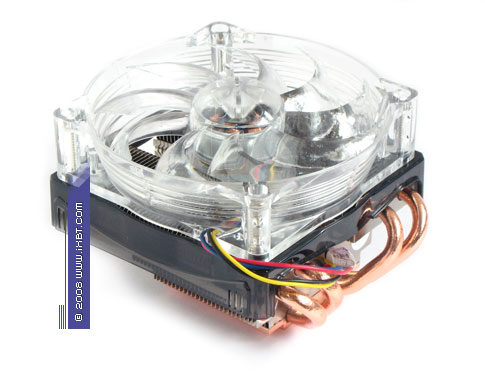The home theater PC (HTPC) concept has taken deep roots owing to its synergistic principles. Relying on stable support of interested consumers, HTPC products have become one of the main driving forces in this industry. They are actively developing and demonstrate good expansion rates in their segment. There are plenty of products in the market, but users often face a paradoxical situation: the absolute majority of HTPC devices is either apparently underperforming and barely able to play HD Video, or excessively powerful (like those SLI monsters in huge Silverstone enclosures). There is nearly no golden mean -- configurations actually optimized for HTPC. Besides, typical HTPCs stubbornly ignore the priority of noiseless or at least low-noise operation. There's no sense for a media center to operate louder than a DVD recorder or a similar device.
Considering all these facts, experienced users have no other choice but to build HTPC machines on their own to get ergonomic solutions for a wide range of tasks, including audio/video/image processing, watching movies/TV, and gaming. Fortunately, it's usually not difficult to find main parts, as the market offers quiet PSUs and hard drives (one can also consider 2.5" notebook HDDs), low-noise graphics cards like ATI Radeon HD 4850/4870 (to say nothing of passively cooled mainstream cards), and HTPC enclosures to any taste and budget. But it's still very difficult to choose another important part -- a CPU cooler. Especially if you need a promising partner for your quad-core processor, which has high requirements to cooling systems.
Today we'll examine three different HTPC coolers: Cooler Master V4, Scythe Shuriken, and Zalman CNPS8700 NT. The primary requirement to a home theater part is compact dimensions (not higher than 90 mm) and High-End components (heat pipes and rich finning). These coolers have all that, so let's proceed straight to their design and usability issues, and then analyze the key point -- actual performance.
Cooler Master V4 (UCI-L9P4-GP)
This cooler offers serious technical parameters despite its compact dimensions (112 x 108 x 75 mm) -- a copper heat sink (63 x 48 x 5 mm, 37 x 38 mm at the base), four copper heat pipes (6 mm in diameter) and combined aluminum finning (some fins are integrated into the base), spiced up with a nice fan (92 x 92 x 25 mm, 2800 rpm, PWM control).

Thermal efficiency of the V4 is also very good. First of all, note the "symbiotic" finning that connects two "independent" fin-stacks (24 fins in each stack, 36 x 16 mm) and an additional heat sink (27 fins) linked to the base of the cooler. This configuration allows to solve three tasks on the road to better heat exchange -- offload the cooler base by providing optimized heat release with the help of an additional heat sink, raise fin efficiency in this additional heat sink (one part of it works with the base of the cooler, while the other part contacts heat pipes), and form four additional heat release elements in "independent" sections. That is, V4 finning uses all its surface area (1600 cm2) for active heat exchange, and it can be as efficient as much bigger tower-like heat sinks.


Another advantage -- all joints in the working medium are implemented with good old soldering, complying with all strict rules of technical etiquette. Thus, thermal resistance is minimized between pipes and the base of the cooler, between the base and fins, and between pipes and fins. Consequently, the entire heat sink becomes more efficient. This is especially important for the compact V4, when each minor thermal issue is relevant, and thorough configuration may lead to decent results.

The on-board fan also looks good (Martech DF0902512B2UN). It's notable for a neat combination of aerodynamic and electromechanical characteristics. Pay attention to the aerodynamic design -- pronounced crescent blades, moderately aggressive angles of attack, and dome-like grid nozzle -- these parameters speak clearly for impeller configuration designed for increased performance and noise reduction. There are no problems with the technical quality of the fan either -- high-Q mechanics (double ball bearing) and neat electric fitting, which efficiently neutralizes structural side noise (the notorious electroacoustic effect, so called "engine popping", is not detected in the noise spectrum of V4).

Nevertheless, we've got some gripes with V4 usability that have to do with the installation procedure for the Intel LGA775 platform. The bundled retention module copies Hyper 212 in many respects. So it's still mandatory to remove a motherboard from an enclosure. Besides, it's not very easy to secure the cooler in a socket -- it requires some manipulations with a screwdriver. Compact design of this cooler makes it difficult to adapt to Intel's reference retention module, but engineers from Cooler Master should have modified the working medium of V4 to facilitate the installation procedure.

However, the cooler is doing much better on the AMD Socket AM2 platform -- the standard mounting bracket with a lever ensures easy installation, practically as comfortable as trivial manipulations with boxed coolers. V4 comes with a preinstalled thermal interface (highly effective thermal grease with composite fill agent based on aluminum oxide and nitride) and PWM control of fan speed (it will be useful, if a user is interested in using corresponding motherboard features).
Write a comment below. No registration needed!







